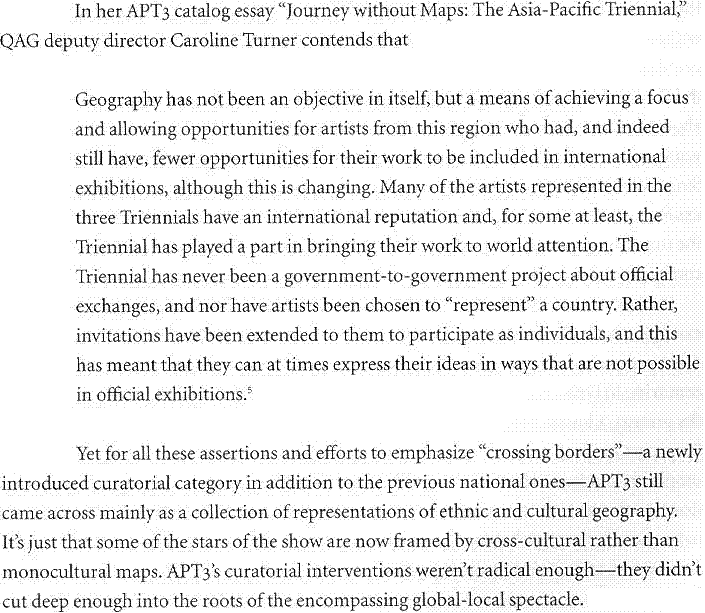Global-local "[...] signifies the further penetration of global capitalism into the local, then presents this local as authentic. "Global-local" reminds me of that other buzzword, "New Asia". These terms suggest an increasing conflation of arts and cultural discourse with the idiom of national -even "transnational"- turims boards."
Lee Weng Choy defines Singapore in terms probably lend from Baudrillard and Marx: "[...] like any other contemporary metropolis, [Singapore] is a hyperreal city of signs, allthough [...] the forces of late capitalism haven't been quite finalized the break between "reality" and "image"." but nonetheless having " [...] become a global-local hub or interzone."
The efforts of modernization in the arts are reflected in:
1989 the Advisory Council on Culture and the Arts led to creation of National Arts Council, the National Haritage Board, the Singapore Arts Museum and the Esplande arts center in order" to position Singapore as a key city in Asia" (Lee Yock Suan, Minister for Information and Arts).An arts scene had to be created. but "what will hold the arts back in the end?"
Lee Weng Choy compares these efforts to the APT:
But there are also some remarks on the parallel historical or ansyncronicle phenomena that can't be found in Singapore, where everything would be planned
:
Contemporary art would have found it's way to Singapore through performance art. Author mentions works by Lim Tzay Chuen and the boy asks... (evoking Duchamps Ready-Made principle the Singapore Art Museum changes in our perception by reducing it's size):
Lee Weng Choy defines Singapore in terms probably lend from Baudrillard and Marx: "[...] like any other contemporary metropolis, [Singapore] is a hyperreal city of signs, allthough [...] the forces of late capitalism haven't been quite finalized the break between "reality" and "image"." but nonetheless having " [...] become a global-local hub or interzone."
The efforts of modernization in the arts are reflected in:
1989 the Advisory Council on Culture and the Arts led to creation of National Arts Council, the National Haritage Board, the Singapore Arts Museum and the Esplande arts center in order" to position Singapore as a key city in Asia" (Lee Yock Suan, Minister for Information and Arts).An arts scene had to be created. but "what will hold the arts back in the end?"
Lee Weng Choy compares these efforts to the APT:
But there are also some remarks on the parallel historical or ansyncronicle phenomena that can't be found in Singapore, where everything would be planned
:
"Sanjay Krishan as written "how scaffolding seems the unchanging future in a city that sees itself in permant transition ... [it] is at once a symbol of the uglyness and the breathtaking energy of the desire for renewal or 'speed', the desire to change rapidly and without remorse."[8]
By leasing in 1985 the themepark (Haw Par Villa) created in 1935 plus the mentioned efforts Singapore also aims to reach World Class, term used by Prime Minister Goh Chok Tong in 1997 at the National Day Dinner. This terms is later ironically used by Lee Wen in his intallation World Class.Contemporary art would have found it's way to Singapore through performance art. Author mentions works by Lim Tzay Chuen and the boy asks... (evoking Duchamps Ready-Made principle the Singapore Art Museum changes in our perception by reducing it's size):
- The author also asserts that the term "Postmodern" not adequate anymore to describe globalization, but perhaps "shizo-chronic".

Keine Kommentare:
Kommentar veröffentlichen